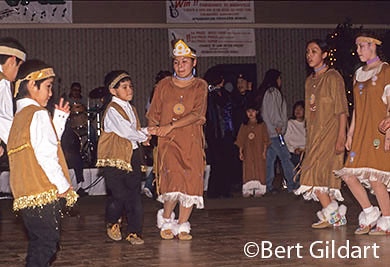Athabascan Fiddle Festival
Note: Several years ago I covered the Athabascan Fiddle Festival for Native Peoples Magazine. The event is an annual one, held in Fairbanks, and it just recently concluded.
The following is an excerpt from that story with comments to follow about photographic techniques and about some of the Athabascan peoples who attended. Janie and I have meet many of these people in the bush, several at trapping camps and many while they’ve been hunting or fishing. These people are a subsistence group, still depending for food on what they extract from the wilderness that flanks their tiny villages. All photographs and text are copyrighted, as is all material presented in my blog.
©Bert Gildart: Fixed forever in my mind is the image of Trimble Gilbert of Arctic Village, a Gwich’in Indian, sitting proud, feet beating up and down in a rhythmic manner, drawing his bow across the strings of his fiddle, creating a sweet, sweet sound that only a handful of skilled musicians can yet produce. Included in that image is the joy of watching hundreds of Athabascan men and women dancing.
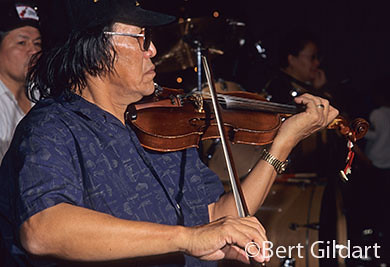
Most consider Trimble Gilbert of Arctic Village to be one of the best of the Athabascan fiddlers. He is in demand throughout both Alaska and much of the Yukon. (See link below)
Elders had risen from wheelchairs to form part of a group that now included individuals who glided and shuffled–bowed and retreated–for almost an hour, until at last–smiling and laughing–a few began to drop from the number, only to regroup for the remainder of the night’s entertainment, for at midnight the festival had only begun.
For me, these memories remain as exhilarating as helping my friend Kenneth Frank of Arctic Village extract dozens of grayling, cod and lake trout from a fishnet at -33°F. The difference is that fiddle playing is intended to offset–perhaps even celebrate–the rigors of life in the “bush.”

Katherine Peter dances with young admirer. Mrs. Peter is the author of several books about her years at Fort Yukon. (See link below.)
“That’s what it is,” said Doris Ward of Fort Yukon, Alaska. “It’s a joyous musical marathon. We just dance and listen, and we have so much fun seeing old friends we’ve shared trap lines and hunting camps with. And, then, for a few days, we forget some of our troubled times and all our hard work…”
TWENTY YEAR DOCUMENTATION
For almost 20 years now, Janie and I have been wandering North American for various magazines using a variety of modes of transportation, to include snowmobile, johnboat and an Airstream travel trailer. Upon return from these trips, which often span months, we organize photographs and then write stories around them. One of the most comprehensive photo studies has included our documentation of the Gwich’in Indians, a tribe that lives further north than any other Indian tribe (Eskimos live further north).
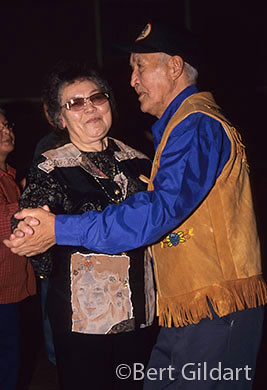
Bertha Underwood and Simon Francis. Francis once shot the "Ice Bear," as it stalked him. Janie and I first meet him following a four month trip on the Yukon and Porcupine rivers. He told us the story. (Follow link, just below.)
Several years ago we covered the Athabascan Fiddle festival, an annual event held in Fairbanks. The event is just as described above, and in many cases, the people I photographed were some of the same individuals I photographed under different circumstances living out in the bush. Trimble Gilbert is one such person, and so were Katherine Peter and Simon Francis.
SIDE TRIP TO ARCTIC VILLAGE
Immediately after the festival Janie and I flew almost 100 miles above the Arctic Circle to visit our good friend Kenneth Frank, whom we also photographed at the festival. From this tiny village of about 80, I then accompanied Kenneth on a 20-mile snowmobile trip to Old John Lake. Temperatures hovered around -30°F.
What an adventure that was, for us to string his 70-foot long net beneath the ice. First, we had to drill 12 holes in the ice and then “thread” the net beneath the ice pushing it with a stick. Next day we returned and hauled out a catch of several hundreds pounds.
This trip for Native Peoples magazine is much on my mind these days as I hope to take my work from my 18 years of documenting the Gwich’in to a different level. To date my stories and photographs from these lengthy trips into the Arctic have appeared in many publications to include National Wildlife, Christian Science Monitor, and Time Life. As well, the United States Information Agency syndicated a story it commissioned me to write to their many overseas outlets.
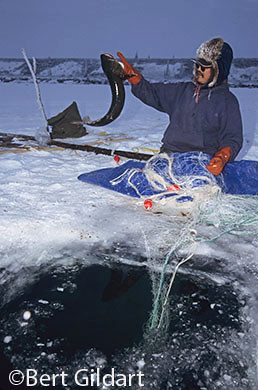
Kenneth Frank at Old John Lake hefts white fish, one from a catch of several hundred pounds. Temperature here on this mid November day is –33°F, and in just another week the sun will remain below the horizon not to return until mid January.
All that said, this group of people remains one of favorites, and we wish them well with all their various endeavors.
PHOTOGRAPHIC TECHNIQUES:
When possible, I used two Nikon strobes to create shadow relief on these subjects. One strobe tends to create flat light or light that is sometimes blocked up in shadows. Janie held one strobe the other was mounted on my camera. Generally I designated the strobe Janie held as the main light and the one on my camera as the fill light, meaning that I backed off the on-camera strobe by up to one full f-stop, though generally a third to two thirds. I also used a strobe for the photograph of Kenneth extracting fish. I angled the strobe up to prevent the light from washing out the snow in the foreground.
TWO YEARS AGO:
*Lessons from Cades Cove (Great Smoky Mountains National Park)
4th ed. Autographed by the Authors
Hiking Shenandoah National Park
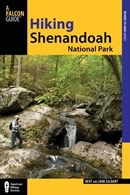 Hiking Shenandoah National Park is the 4th edition of a favorite guide book, created by Bert & Janie, a professional husband-wife journalism team. Lots of updates including more waterfall trails, updated descriptions of confusing trail junctions, and new color photographs. New text describes more of the park’s compelling natural history. Often the descriptions are personal as the Gildarts have hiked virtually every single park trail, sometimes repeatedly.
Hiking Shenandoah National Park is the 4th edition of a favorite guide book, created by Bert & Janie, a professional husband-wife journalism team. Lots of updates including more waterfall trails, updated descriptions of confusing trail junctions, and new color photographs. New text describes more of the park’s compelling natural history. Often the descriptions are personal as the Gildarts have hiked virtually every single park trail, sometimes repeatedly.
Big Sky Country is beautiful
Montana Icons: 50 Classic Symbols of the Treasure State
![]() Montana Icons is a book for lovers of the western vista. Features photographs of fifty famous landmarks from what many call the “Last Best Place.” The book will make you feel homesick for Montana even if you already live here. Bert Gildart’s varied careers in Montana (Bus driver on an Indian reservation, a teacher, backcountry ranger, as well as a newspaper reporter, and photographer) have given him a special view of Montana, which he shares in this book. Share the view; click here.
Montana Icons is a book for lovers of the western vista. Features photographs of fifty famous landmarks from what many call the “Last Best Place.” The book will make you feel homesick for Montana even if you already live here. Bert Gildart’s varied careers in Montana (Bus driver on an Indian reservation, a teacher, backcountry ranger, as well as a newspaper reporter, and photographer) have given him a special view of Montana, which he shares in this book. Share the view; click here.
$16.95 + Autographed Copy
What makes Glacier, Glacier?
Glacier Icons: 50 Classic Views of the Crown of the Continent
![]() Glacier Icons: What makes Glacier Park so special? In this book you can discover the story behind fifty of this park’s most amazing features. With this entertaining collection of photos, anecdotes and little known facts, Bert Gildart will be your backcountry guide. A former Glacier backcountry ranger turned writer/photographer, his hundreds of stories and images have appeared in literally dozens of periodicals including Time/Life, Smithsonian, and Field & Stream. Take a look at Glacier Icons
Glacier Icons: What makes Glacier Park so special? In this book you can discover the story behind fifty of this park’s most amazing features. With this entertaining collection of photos, anecdotes and little known facts, Bert Gildart will be your backcountry guide. A former Glacier backcountry ranger turned writer/photographer, his hundreds of stories and images have appeared in literally dozens of periodicals including Time/Life, Smithsonian, and Field & Stream. Take a look at Glacier Icons
$16.95 + Autographed Copy
